Search Result
Results for "
human fibroblasts
" in MedChemExpress (MCE) Product Catalog:
1
Biochemical Assay Reagents
2
Isotope-Labeled Compounds
| Cat. No. |
Product Name |
Target |
Research Areas |
Chemical Structure |
-
- HY-108999A
-
|
BWA770U
|
DNA/RNA Synthesis
|
Cancer
|
|
Crisnatol (BWA770U) is an orally active and anticancer agent, and a member of the arylmethylaminopropanediol class of DNA intercalators. Crisnatol shows in vitro cytotoxicity against human breast cancer cells, but not normal human skin fibroblasts .
|
-
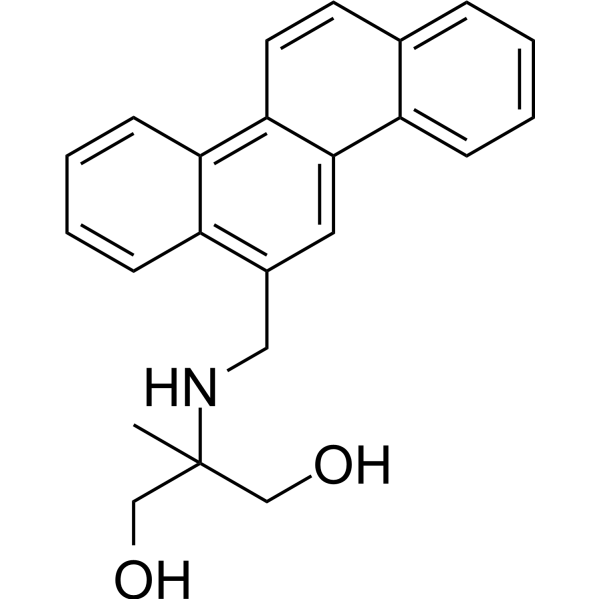
-
- HY-W020044
-
|
DL-α-Tocopherol
|
Ferroptosis
|
Others
|
|
DL-alpha-Tocopherol is a synthetic vitamin E, with antioxidation effect. DL-alpha-Tocopherol protects human skin fibroblasts against the cytotoxic effect of UVB .
|
-
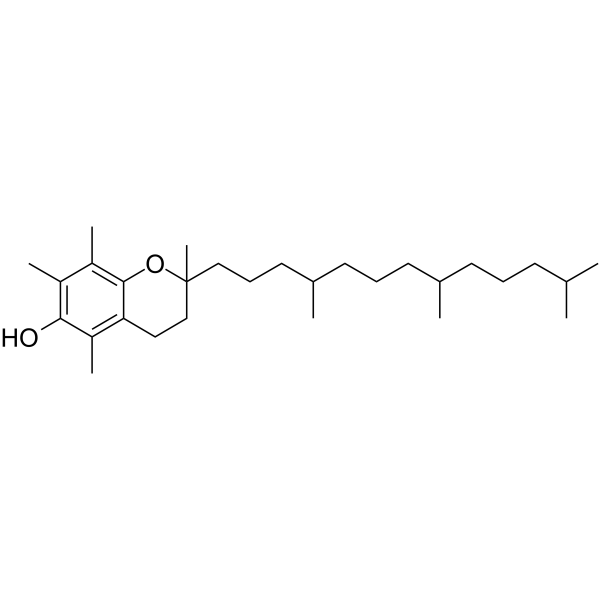
-
- HY-108999
-
|
BWA770U mesylate
|
DNA/RNA Synthesis
|
Cancer
|
|
Crisnatol (BWA770U) mesylate is an orally active and anticancer agent, and a member of the arylmethylaminopropanediol class of DNA intercalators. Crisnatol mesylate shows in vitro cytotoxicity against human breast cancer cells, but not normal human skin fibroblasts .
|
-
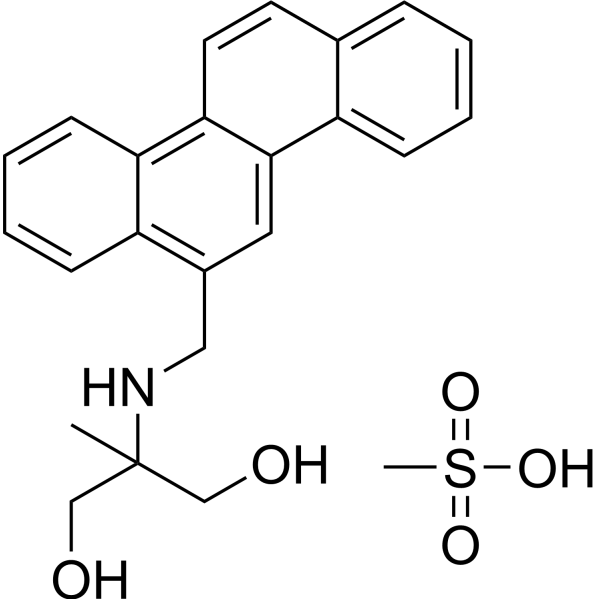
-
- HY-N1326
-
|
Santamarin; Balchanin
|
Keap1-Nrf2
|
Inflammation/Immunology
|
|
Santamarine (Santamarin), a sesquiterpene lactone, increases HO-1 expression through Nrf2 translocation and suppresses NO, PGE2, TNF-α, and IL-1β production through inhibition of NF-κB translocation in LPS-induced macrophages. Santamarine shows anti-photoaging properties via inhibition of MAPK/AP-1 and stimulation of TGF-β/Smad signaling in UVA-irradiated human dermal fibroblasts (HDFs). Antioxidant activities .
|
-
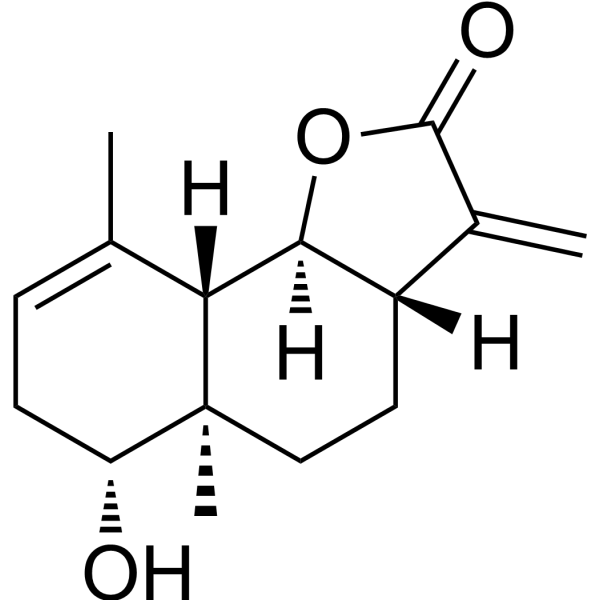
-
- HY-P3544
-
-
![Lys-[Hyp3]-Bradykinin](//file.medchemexpress.com/product_pic/hy-p3544.gif)
-
- HY-152086
-
|
|
Dynamin
|
Cardiovascular Disease
|
|
DRP1i27 is a potent inhibitor of human Drp1 (dynamin-related protein 1). DRP1i27 binds to the GTPase site of Drp1, with hydrogen bonds to Gln34 and Asp218. DRP1i27 targets Drp1-mediated mitochondrial fission in cell line models and protects against simulated ischemia-reperfusion injury .
|
-

-
- HY-114297
-
|
|
Endogenous Metabolite
|
Others
|
|
Zymosterol is a Cholesterol (HY-N0322) biosynthesis metabolite. Zymosterol, a precursor of Cholesterol, is found mostly in the plasma membrane. Zymosterol circulates within the cell .
|
-

-
- HY-152086A
-
|
|
Dynamin
|
Cardiovascular Disease
|
|
DRP1i27 dihydrochloride is a potent inhibitor of human Drp1 (dynamin-related protein 1). DRP1i27 dihydrochloride binds to the GTPase site of Drp1, with hydrogen bonds to Gln34 and Asp218. DRP1i27 dihydrochloride targets Drp1-mediated mitochondrial fission in cell line models and protects against simulated ischemia-reperfusion injury .
|
-
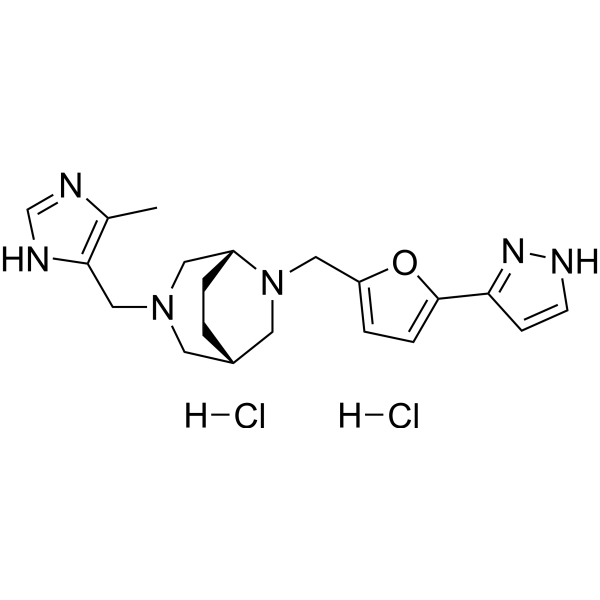
-
- HY-N12653
-
|
(-)-Exserohilone
|
Reactive Oxygen Species
|
Metabolic Disease
|
|
Exserohilone ((-)-Exserohilone) is a thiodiketopiperazine derivative that exhibits the inhibition of TNF-α-induced ROS generation and MMP-1 secretion. Exserohilone increases the procollagen type I α1 secretion in human dermal fibroblasts .
|
-
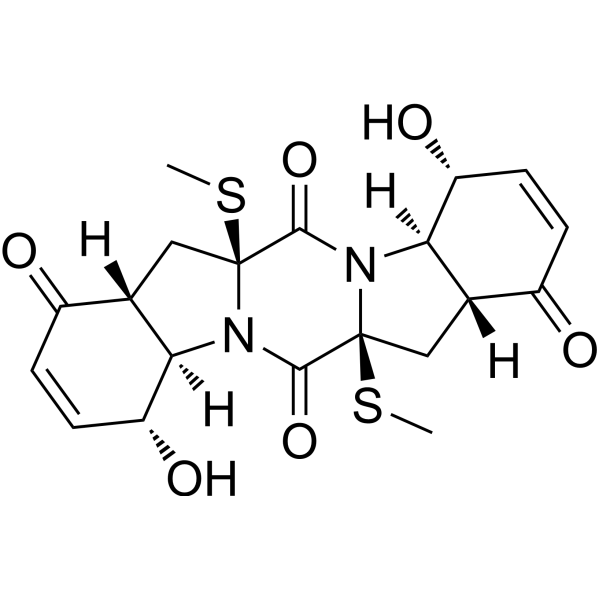
-
- HY-B0607
-
|
NTBC; Nitisone; SC0735
|
HPPD
|
Metabolic Disease
|
|
Nitisinone is an orally active, competitive and reversible 4-hydroxyphenylpyruvate dioxygenase (4-HPPD) inhibitor with an IC50 of 173 nM. Nitisinone promotes tyrosine accumulation in a dose-dependent manner. nitisinone can be used in studies of hereditary tyrosinemia type 1 (HT-1) (a rare genetic disorder) and albinism .
|
-
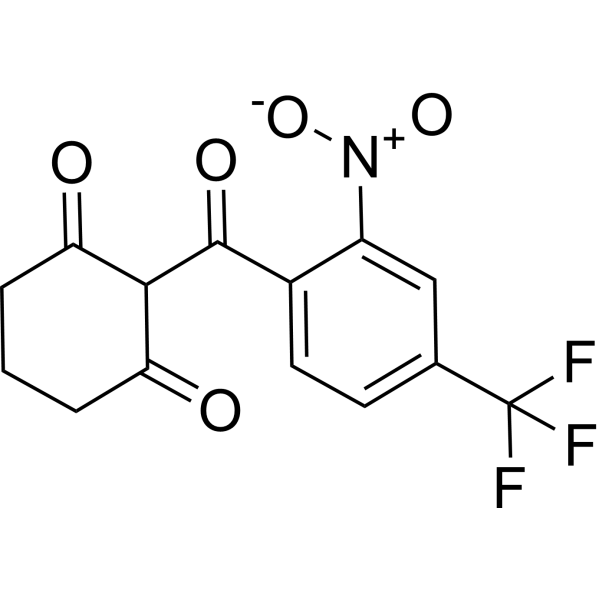
-
- HY-147505
-
|
|
Bacterial
Fungal
|
Infection
|
|
Antitubercular agent-21 (Compound 15) is an antitubercular agent with an MIC of o.4 µg/mL against M. tuberculosis H37Rv. Antitubercular agent-21 exhibits lower activity against other microorganism such as bacteria gram-positive, gram-negative or fungi. Antitubercular agent-21 shows low cytotoxicity .
|
-
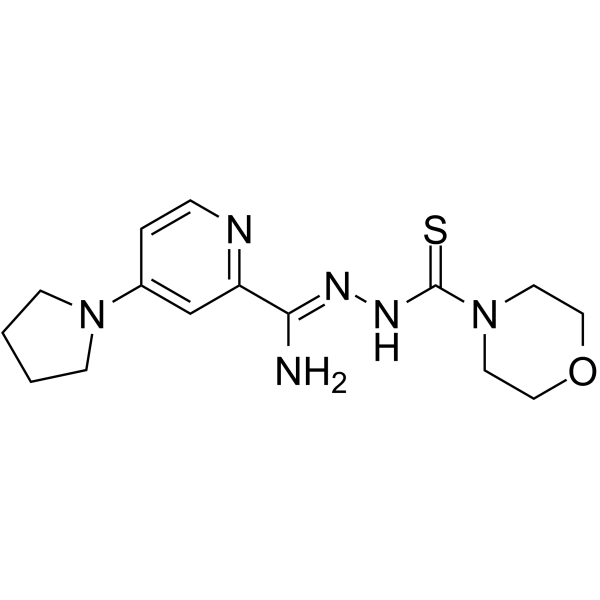
-
- HY-W745164
-
|
|
MMP
|
Inflammation/Immunology
|
|
3,3′-Bisdemethylpinoresinol, lignin, is a nature product and has MMP-1 inhibitory activity in UVA-irradiated human dermal fibroblasts. 3,3′-Bisdemethylpinoresinol can be isolated from the seeds of Morinda citrifolia .
|
-
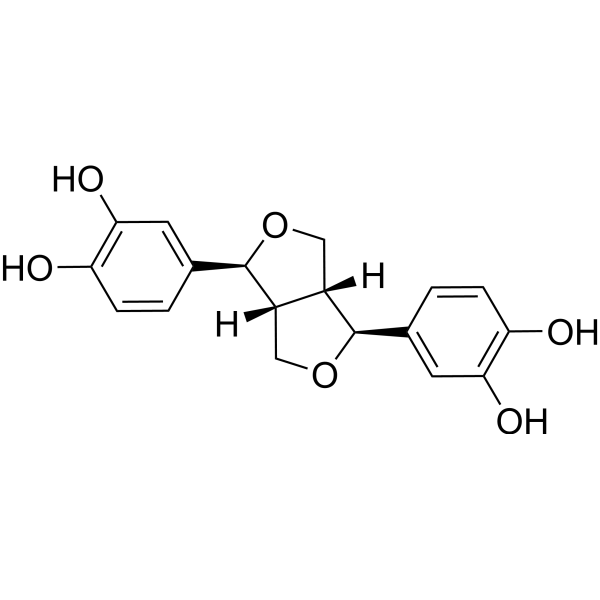
-
- HY-N5123
-
|
|
Others
|
Others
|
|
α-L-Rhamnose is a terminal residue of steviol glycosides Dulcoside A and Dulcoside B. α-L-Rhamnose recognizing lectin site of human dermal fibroblasts functions as a signal transducer: modulation of Ca 2+ fluxes and gene expression .
|
-
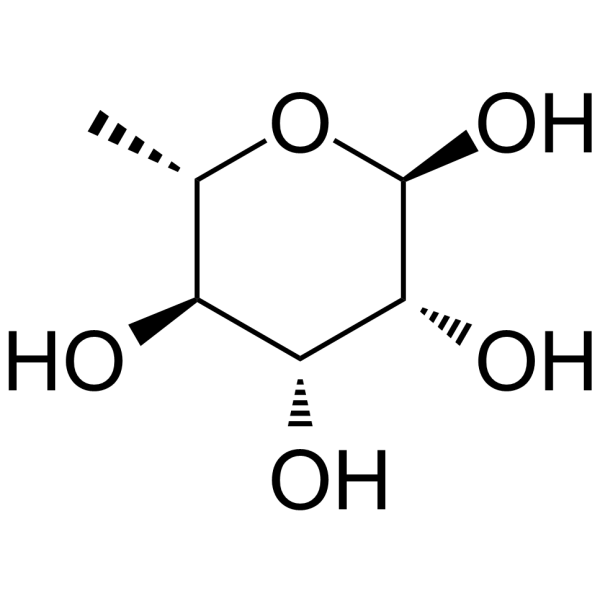
-
- HY-P3061
-
|
|
Bradykinin Receptor
|
Cardiovascular Disease
Endocrinology
|
|
[Hyp3]-Bradykinin, naturally occurring peptide hormone, is a bradykinin receptor agonist. [Hyp3]-Bradykinin interacts with B2-bradykinin receptors and stimulates inositol phosphate production in cultured human fibroblasts .
|
-
![[Hyp3]-Bradykinin](//file.medchemexpress.com/product_pic/hy-p3061.gif)
-
- HY-N1031
-
|
12-epi-Vitexolide D; Curcucomosin C
|
|
|
|
Vitexolide E is a diterpenoid compound isolated from the leaves of the Malaysian species Vitex vestita. Vitexolide E shows cytotoxic activities against the HCT-116 cancer cell line and human fetal lung fibroblast MRC5 cell line .
|
-

-
- HY-123464
-
|
|
Ras
|
Cancer
|
|
RBC10 is an anti-cancer agent. RBC10 inhibits the binding of Ral to its effector RALBP1. RBC10 also inhibits Ral-mediated cell spreading of murine embryonic fibroblasts and anchorage-independent growth of human cancer cell lines .
|
-

-
- HY-125987
-
|
|
Others
|
Cancer
|
|
RBC6 is an inhibitor of GTPases RalA. RBC6 inhibits binding of Ral to its effector RALBP1. RBC6 also inhibits Ral-mediated cell spreading of murine embryonic fibroblasts, as well as anchorage-independent growth of human cancer celllines .
|
-
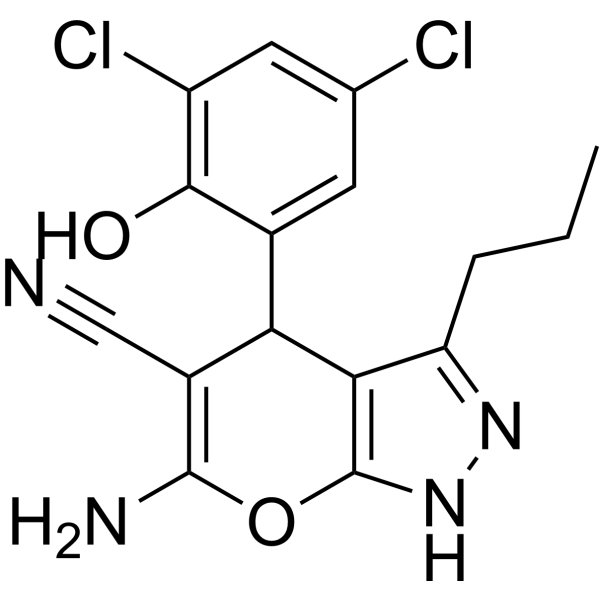
-
- HY-10432G
-
|
|
Anaplastic lymphoma kinase (ALK)
|
Cancer
|
|
A 83-01 (GMP) is A 83-01 (HY-10432) produced by using GMP guidelines. GMP small molecules works appropriately as an auxiliary reagent for cell therapy manufacture. A 83-01 is a potent ALK4/5/7 inhibitor .
|
-
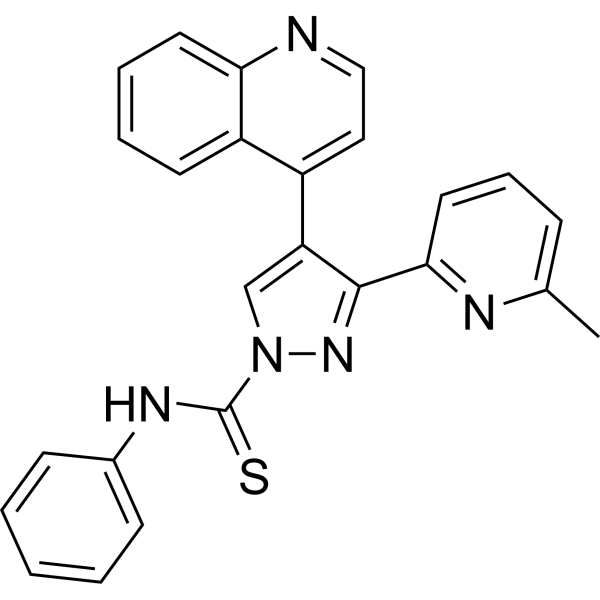
-
- HY-W020044S
-
|
|
Ferroptosis
|
Others
|
|
DL-alpha-Tocopherol- 13C3 is the 13C-labeled DL-alpha-Tocopherol. DL-alpha-Tocopherol is a synthetic vitamin E, with antioxidation effect. DL-alpha-Tocopherol protects human skin fibroblasts against the cytotoxic effect of UVB[1].
|
-
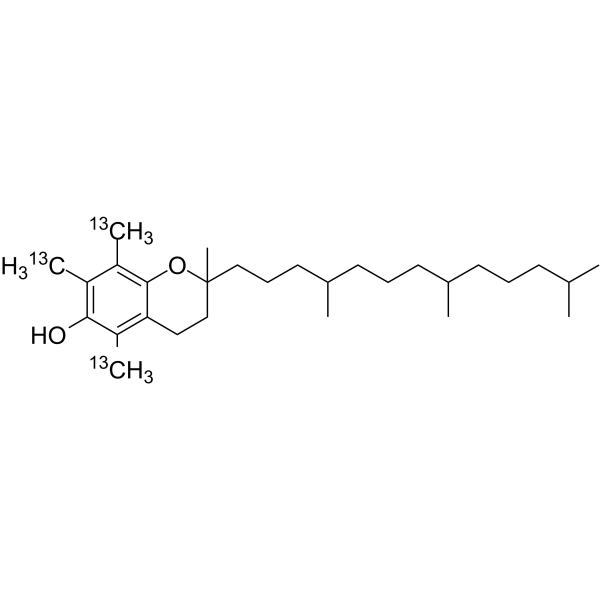
-
- HY-W020044S1
-
|
|
Ferroptosis
|
Others
|
|
DL-alpha-Tocopherol-d9 is the deuterium labeled DL-alpha-Tocopherol[1]. DL-alpha-Tocopherol is a synthetic vitamin E, with antioxidation effect. DL-alpha-Tocopherol protects human skin fibroblasts against the cytotoxic effect of UVB[2].
|
-
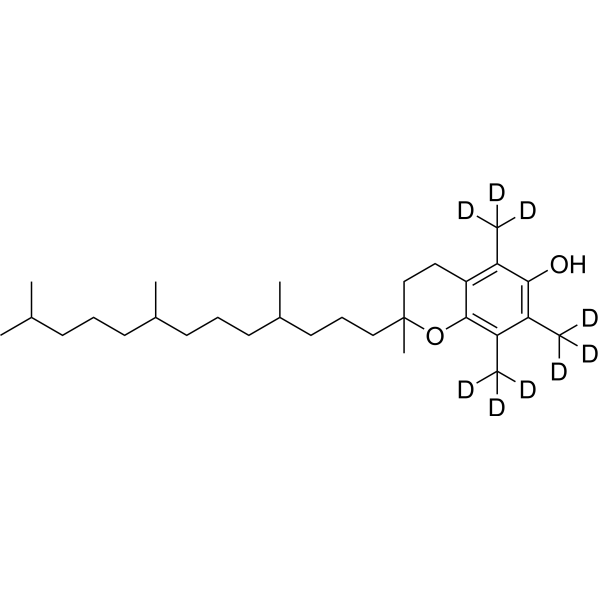
-
- HY-103289
-
|
|
Bradykinin Receptor
|
Metabolic Disease
Inflammation/Immunology
|
|
MEN 11270, a cyclic decapeptide, is a B2 kinin receptor antagonist. MEN 11270 bound with high-affinity to the B2 kinin receptor constitutively expressed by WI38 human fibroblasts, inhibiting 3H-bradykinin (BK) with a pKi value of 10.3 .
|
-

-
- HY-W020044R
-
|
|
Ferroptosis
|
Others
|
|
DL-alpha-Tocopherol (Standard) is the analytical standard of DL-alpha-Tocopherol. This product is intended for research and analytical applications. DL-alpha-Tocopherol is a synthetic vitamin E, with antioxidation effect. DL-alpha-Tocopherol protects human skin fibroblasts against the cytotoxic effect of UVB .
|
-
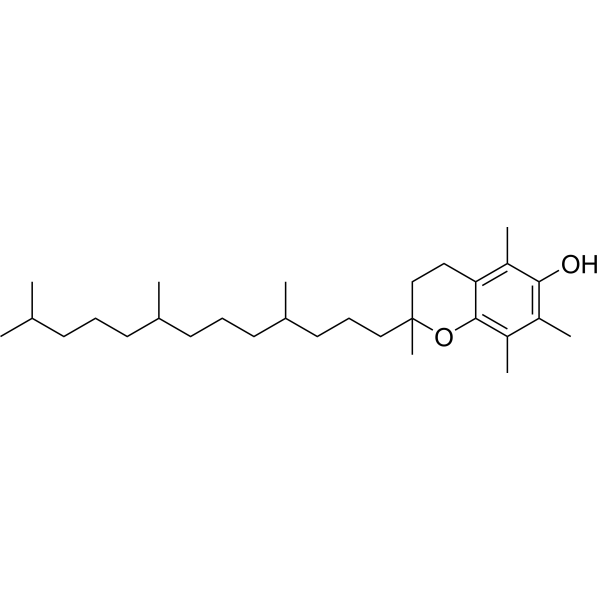
-
- HY-145358
-
|
|
PI3K
|
Cancer
|
|
FAP-PI3KI1 is a fibroblast-activated protein (FAP)-targeted PI3K inhibitor that selectively targets FAP-expressing human idiopathic pulmonary fibrosis (IPF) cells and effectively inhibits collagen synthesis and reduces collagen deposition .
|
-
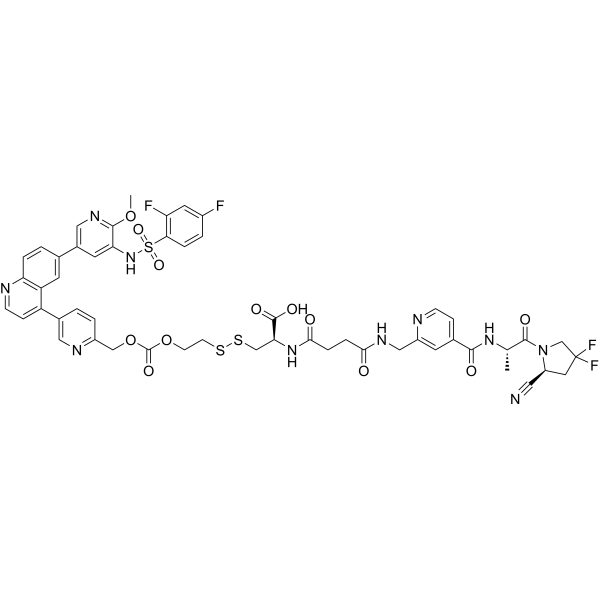
-
- HY-P99902
-
|
FAP-IL2v
|
Interleukin Related
|
Cancer
|
|
Simlukafusp alfa (FAP-IL2v) is an immunocytokine comprising an antibody against fibroblast activation protein α (FAPα) and an IL-2 variant that only binds IL-2Rβγ. Isotype: human IgG1 .
|
-

-
- HY-15039
-
|
|
Bradykinin Receptor
|
Metabolic Disease
Inflammation/Immunology
Endocrinology
|
|
SSR240612 is a potent, and orally active specific non-peptide bradykinin B1 receptor antagonist, with Kis of 0.48 nM and 0.73 nM for B1 kinin receptors of human fibroblast MRC5 and HEK cells expressing human B1 receptors, 481 nM and 358 nM for B2 receptors of guinea pig ileum membranes and CHO cells expressing human B1 receptor, respectively.
|
-
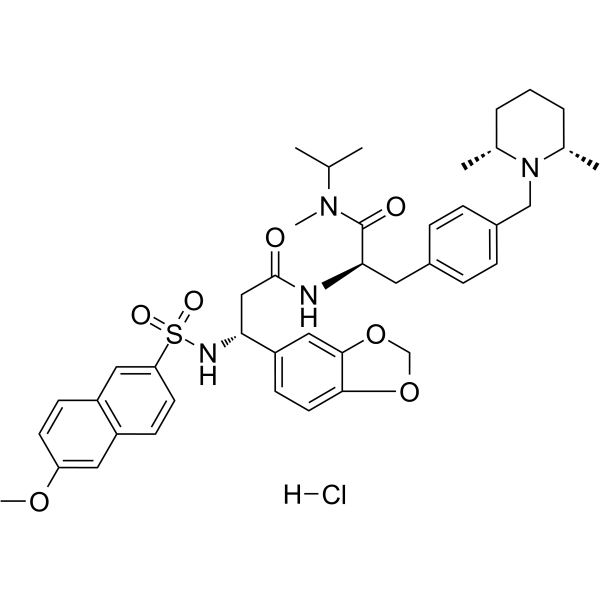
-
- HY-B1192
-
|
β-Estradiol 3-benzoate; 17β-Estradiol 3-benzoate
|
Estrogen Receptor/ERR
HBV
Bcl-2 Family
|
Neurological Disease
|
|
Estradiol benzoate (β-Estradiol 3-benzoate) is a HBx protein inhibitor and inhibits androgen and hepatitis B virus (HBV) transcription, replication. Estradiol benzoate shows antifertility effects, anti- Toxoplasma gondii activity and can improve memory behavior of Ovariectomy (Ovx) female mice .
|
-
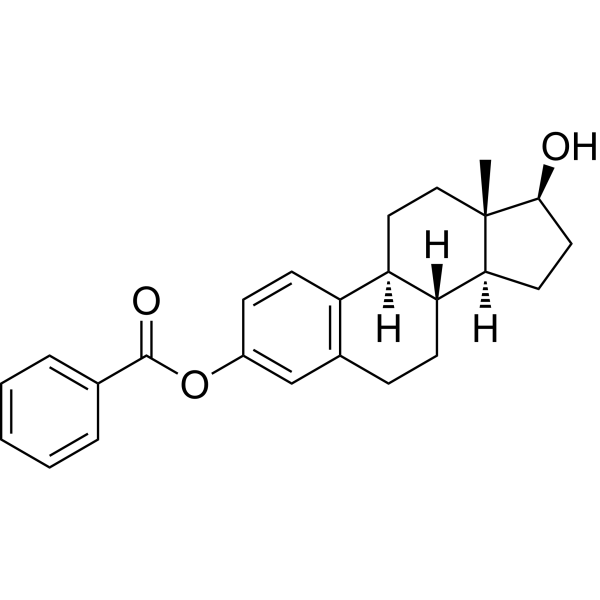
-
- HY-108659
-
|
|
P2Y Receptor
|
Inflammation/Immunology
|
|
NF340 is a potent and selective P2Y11 receptor antagonist. NF340 inhibits the activity of P2Y11R by completely combining with ATP-binding amino acid residues. NF340 ameliorates inflammation in human fibroblast-like synoviocytes and can be used for rheumatoid arthritis research .
|
-

-
- HY-W014940
-
|
|
Reactive Oxygen Species
Apoptosis
|
Others
|
|
Ethylene glycol dimethacrylate is a methacrylate monomer, exhibits cytotoxic and genotoxic effects on human gingival fibroblasts (HGFs). Ethylene glycol dimethacrylate increases intracellular reactive oxygen species (ROS) production, causes DNA damage, increases apoptosis and causes cell cycle arrest in G1/G0 phase .
|
-
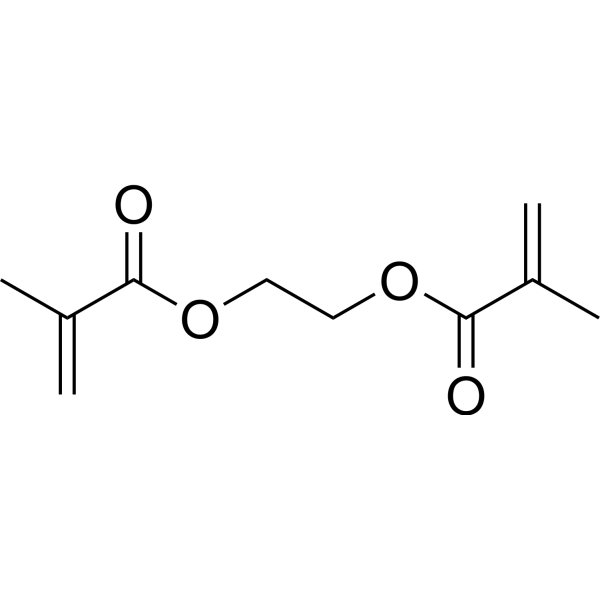
-
- HY-N4298
-
|
|
MMP
|
Metabolic Disease
Inflammation/Immunology
|
|
Epitheaflagallin 3-O-gallate is a minor polyphenol in black tea. Epitheaflagallin 3-O-gallate exhibits versatile physiological functions in vivo and in vitro, including antioxidative activity, pancreatic lipase inhibition, Streptococcus sorbinusglycosyltransferase inhibition, and an inhibiting effect on the activity of matrix metalloprotease-1 and -3 and their synthesis by human gingival fibroblasts .
|
-
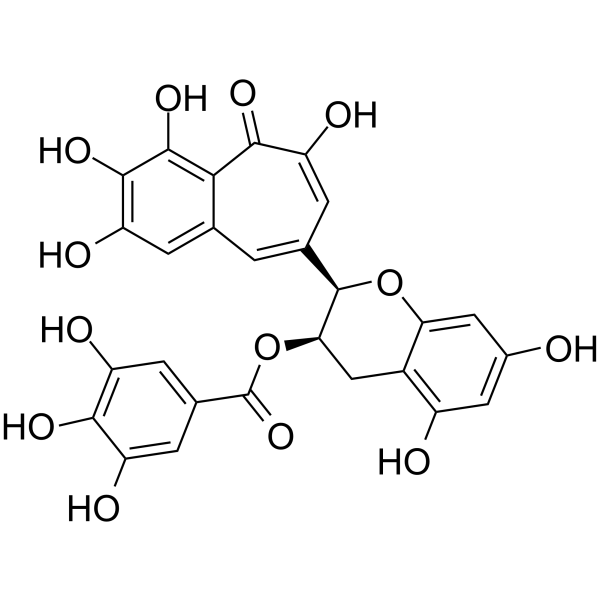
-
- HY-120006A
-
|
|
ERK
|
Cardiovascular Disease
|
|
(rel)-AR234960 is an active relative configuration of AR234960. AR234960, a non-peptide MAS (a G protein-coupled receptor) agonist, increases both mRNA and protein levels of CTGF via ERK1/2 signaling in HEK293-MAS cells and adult human cardiac fibroblasts .
|
-

-
- HY-15259A
-
|
|
Acetyl-CoA Carboxylase
|
Metabolic Disease
|
|
CP-640186 hydrochloride is an orally active and cell-permeable Acetyl-CoA carboxylase (ACC) inhibitor with IC50s of 53 nM and 61 nM for rat liver ACC1 and rat skeletal muscle ACC2 respectively. Acetyl-CoA carboxylase (ACC) is a key enzyme of fatty acid metabolism that enables the synthesis of malonyl-CoA. CP-640186 hydrochloride can also stimulate muscle fatty acid oxidation .
|
-

-
- HY-15259
-
|
|
Acetyl-CoA Carboxylase
|
Metabolic Disease
|
|
CP-640186 is an orally active and cell-permeable Acetyl-CoA carboxylase (ACC) inhibitor with IC50s of 53 nM and 61 nM for rat liver ACC1 and rat skeletal muscle ACC2 respectively. Acetyl-CoA carboxylase (ACC) is a key enzyme of fatty acid metabolism that enables the synthesis of malonyl-CoA. CP-640186 can also stimulate muscle fatty acid oxidation .
|
-

-
- HY-15768
-
|
GM6001; Galardin
|
MMP
|
Cancer
|
|
Ilomastat (GM6001) is a potent and broad spectrum matrix metalloprotease (MMP) inhibitor, inhibits MMPs (IC50s, 1.5 nM for MMP-1; 1.1 nM for MMP-2; 1.9 nM for MMP-3; 0.5 nM for MMP-9), with a Ki of 0.4 nM for human skin fibroblast collagenase (MMP-1).
|
-
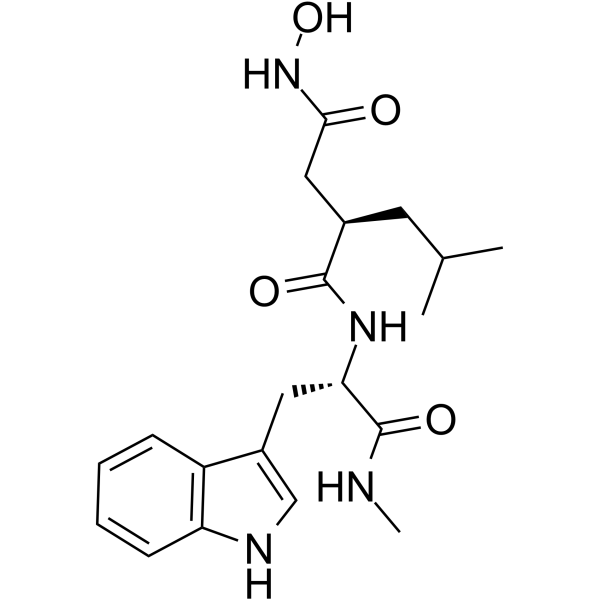
-
- HY-144663
-
|
|
Bacterial
Thymidylate Synthase
|
Infection
|
|
MtTMPK-IN-1 (compound 3) is a potent Mycobacterium tuberculosis thymidylate kinase (MtTMPK) inhibitor with an IC50 value of 2.5 μM. MtTMPK-IN-1 has moderate to weak activity against Mtb H37Rv and low cytotoxicity in human fibroblast cells MRC-5. MtTMPK-IN-1 can be used for researching tuberculosis .
|
-

-
- HY-119358
-
|
|
Reactive Oxygen Species
Apoptosis
|
Inflammation/Immunology
|
|
Traumatic Acid is a wound healing agent and a cytokinin (phytohormone). Traumatic Acid enhances the biosynthesis of collagen in cultured human skin fibroblasts. Traumatic Acid inhibits MCF-7 breast cancer cells viability and enhances apoptosis and oxidative stress. Traumatic Acid can be used in studies of cancer, circulatory disorders (including arterial hypertension), and skin diseases associated with oxidative stress and impaired collagen biosynthesis .
|
-
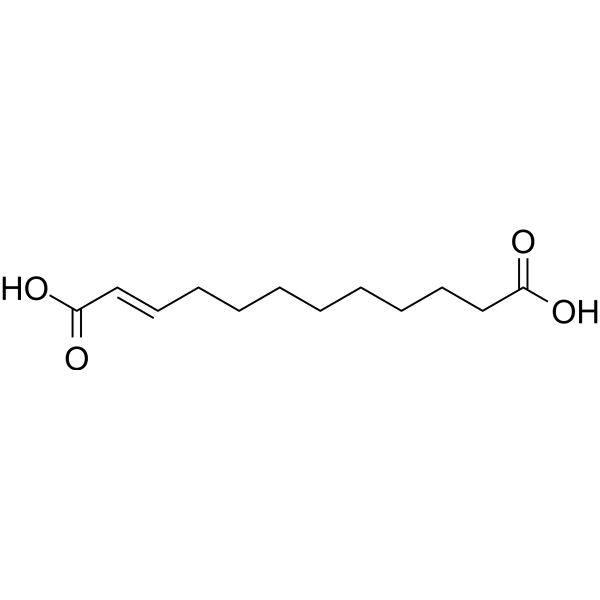
-
- HY-125918
-
|
Pingyangmycin hydrochloride
|
Apoptosis
Antibiotic
|
Infection
Cancer
|
|
Bleomycin A5 (Pingyangmycin) hydrochloride is an anti-neoplastic glycoprotein antibiotic. Bleomycin A5 suppresses Drp1-mediated mitochondrial fission and induces apoptosis in human nasal polyp-derived fibroblasts. Bleomycin A5 hydrochloride has anticancer activities relying on its ability to produce RNA and DNA breaks, thus, leading to cell death ..
|
-

-
- HY-N1190
-
|
(±)-Syringaresinol
|
|
|
|
DL-Syringaresinol ((±)-Syringaresinol), a lignin, inhibits UVA-induced upregulation of MMP-1 by suppressing MAPK/AP-1 signaling in human HaCaT keratinocytes and dermal fibroblasts (HDFs). DL-Syringaresinol has antiphotoaging properties against UVA-induced skin aging. DL-Syringaresinol exhibits weak antimycobacterial activity against Mycobacterium tuberculosis H37Rv .
|
-
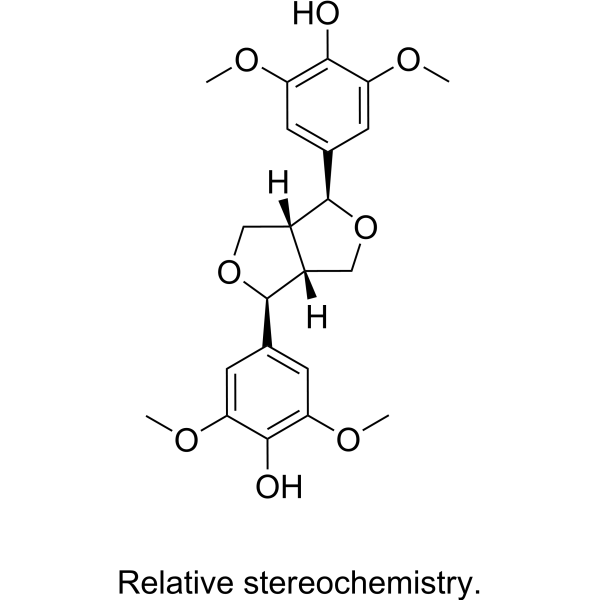
-
- HY-P3513
-
|
|
ERK
MMP
|
Neurological Disease
|
|
β-Neo-Endorphin is an endogenous opioid peptide. β-Neo-Endorphin is a hypothalamic “big” Leu-enkephalin of porcine origin. β-Neo-Endorphin shows activation of the Erk1/2, MMP-2 and MMP-9 .
|
-

-
- HY-12688
-
|
|
Endogenous Metabolite
Reactive Oxygen Species
|
Neurological Disease
|
|
Succinyl phosphonate is an α-ketoglutarate dehydrogenase (KGDHC) inhibitor, effective inhibits (KGDHC) in muscle, bacterial, brain, and cultured human fibroblasts . Succinyl phosphonate trisodium salt is an 2-oxoglutarate dehydrogenase (OGDH) inhibitor, impairs viability of cancer cells in a cell-specific metabolism-dependent manner . Succinyl phosphonate trisodium salt inhibits the glutamate-induced ROS production in glutamate-stimulated hippocampal neurons in situ .
|
-
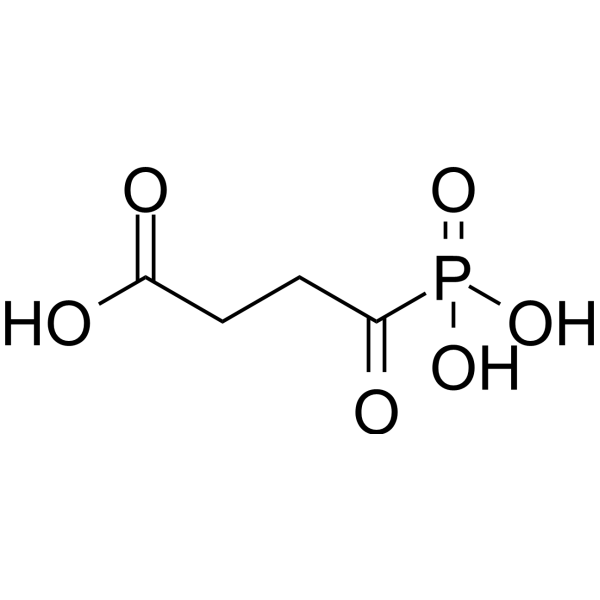
-
- HY-12688A
-
|
|
Endogenous Metabolite
Reactive Oxygen Species
|
Neurological Disease
Metabolic Disease
Cancer
|
|
Succinyl phosphonate trisodium salt is an α-ketoglutarate dehydrogenase (KGDHC) inhibitor, effective inhibits (KGDHC) in muscle, bacterial, brain, and cultured human fibroblasts . Succinyl phosphonate trisodium salt is an 2-oxoglutarate dehydrogenase (OGDH) inhibitor, impairs viability of cancer cells in a cell-specific metabolism-dependent manner . Succinyl phosphonate trisodium salt inhibits the glutamate-induced ROS production in glutamate-stimulated hippocampal neurons in situ .
|
-
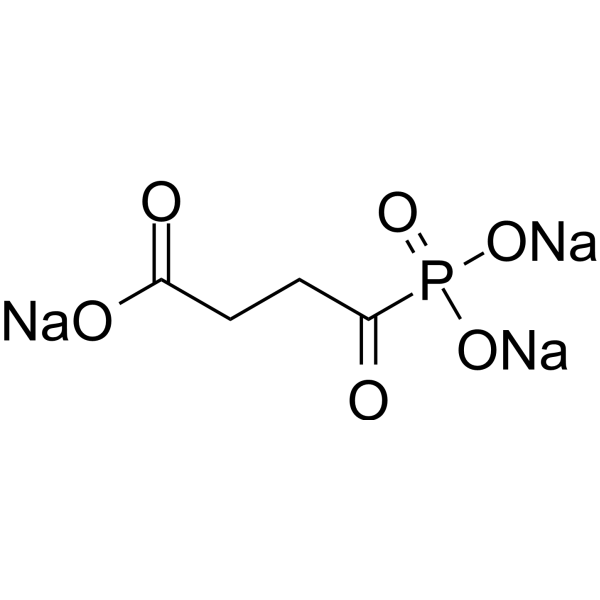
-
- HY-149022
-
|
|
HSV
Orthopoxvirus
|
Infection
|
|
HSV-1/HSV-2-IN-1 (compound 7d) is a HSV-1 and HSV-2 inhibitor, with EC50s of 7.6, 7.6, 4, and 12 μM for HSV-1 (KOS), HSV-2 (G), HSV-1 TK - KOS ACV r and vaccinia virus in human embryonic lung fibroblast cell cultures .
|
-
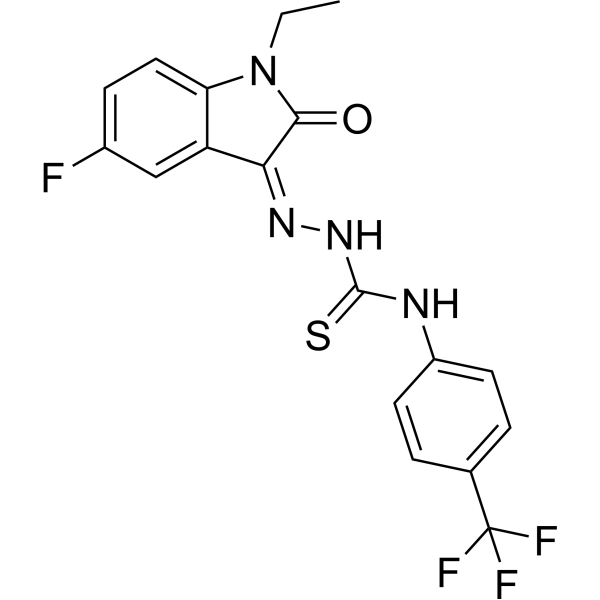
-
- HY-121172
-
|
|
HIF/HIF Prolyl-Hydroxylase
|
Cancer
|
|
1,4-DPCA, a potent prolyl-4-hydroxylase inhibitor, is a collagen hydroxylation inhibitor in human foreskin fibroblasts with an IC50 of 2.4 µM. 1,4-DPCA inhibits prolyl-4-hydroxylases α isoforms stabilizes HIF-1α protein. 1,4-DPCA also inhibits factor inhibiting HIF (FIH) with an IC50 of 60 μM .
|
-
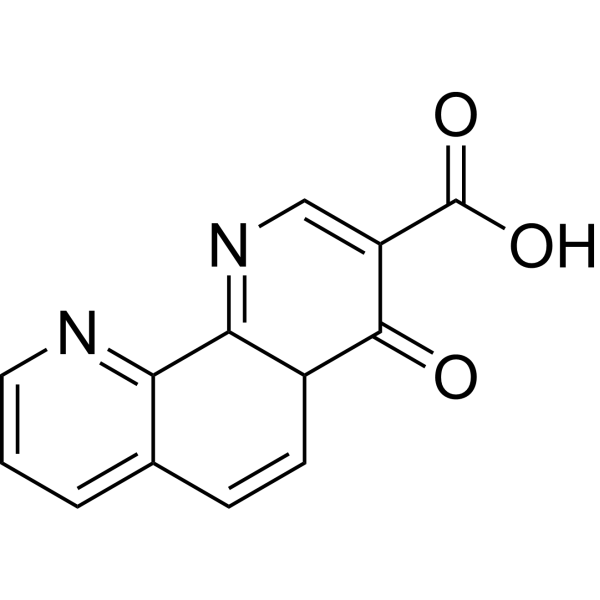
-
- HY-144664
-
|
|
Bacterial
Thymidylate Synthase
|
Infection
|
|
MtTMPK-IN-2 (compound 15) is a potent Mycobacterium tuberculosis thymidylate kinase (MtTMPK) inhibitor with an IC50 value of 1.1 μM. MtTMPK-IN-2 has inhibitory activity against Mtb H37Rv (MIC = 12.5 μM). MtTMPK-IN-2 exhibits certain cytotoxicity in human fibroblast cells MRC-5 (EC50 = 6.1 μM). MtTMPK-IN-2 can be used for researching tuberculosis .
|
-
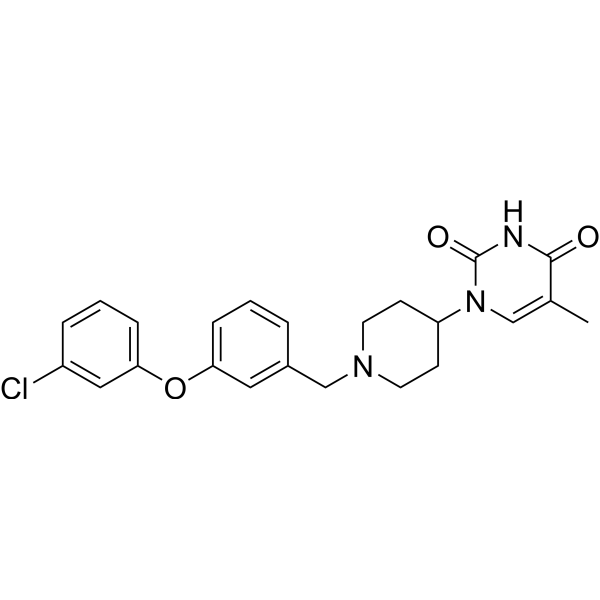
-
- HY-144665
-
|
|
Bacterial
Thymidylate Synthase
|
Infection
|
|
MtTMPK-IN-3 (compound 25) is a potent Mycobacterium tuberculosis thymidylate kinase (MtTMPK) inhibitor with an IC50 value of 0.12 μM. MtTMPK-IN-3 has inhibitory activity against Mtb H37Rv (MIC = 12.5 μM). MtTMPK-IN-3 exhibits certain cytotoxicity in human fibroblast cells MRC-5 (EC50 = 12.5 μM). MtTMPK-IN-3 can be used for researching tuberculosis .
|
-
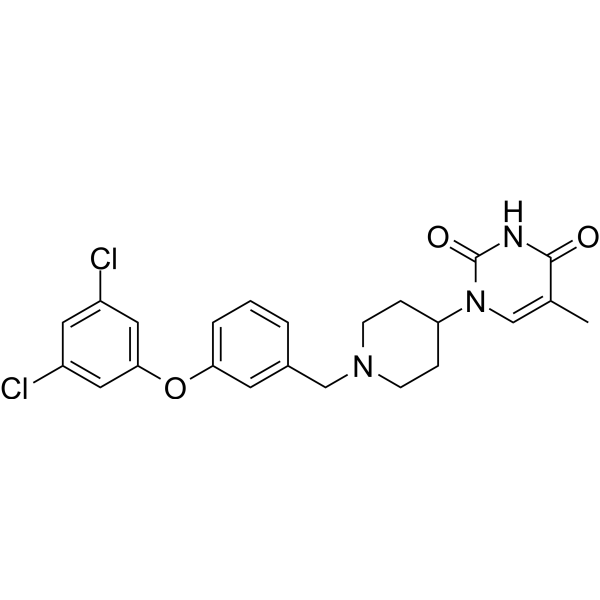
-
- HY-12303
-
OAC1
1 Publications Verification
|
Oct3/4
TET Protein
|
Cancer
|
|
OAC1 is a potent Oct4 activator. OAC1 activates Oct4 and Nanog promoters and enhances induced pluripotent stem cells (iPSC) formation. OAC1 activates OCT4 through upregulation of HOXB4 expression. OAC1 increases transcription of the Oct4-Nanog-Sox2 triad and TET1. OAC1 facilitates the reprogramming of cells by enhancing efficiency and shortening the reprogramming time .
|
-
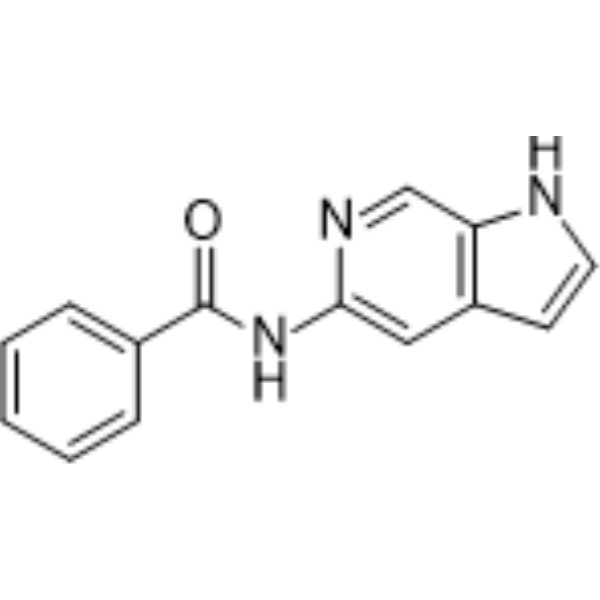
-
- HY-155732
-
|
|
Parasite
|
Infection
|
|
NPD-2975 (compound 30) is an orally active antitrypanosomal agent, against Human African Trypanosomiasis (HAT). NPD-2975 has low toxicity potential against human MRC-5 lung fibroblasts, and acute mouse model of T. b. brucei infection. NPD-2975 shows acceptable metabolic stability, inhibits T. b. brucei with IC500 of 70 nM in vitro. NPD-2975 also inhibits CYP enzymes resulted in IC50 values of 0.16 and 0.42 μM against CYP1A2 and CYP2C19, respectively .
|
-
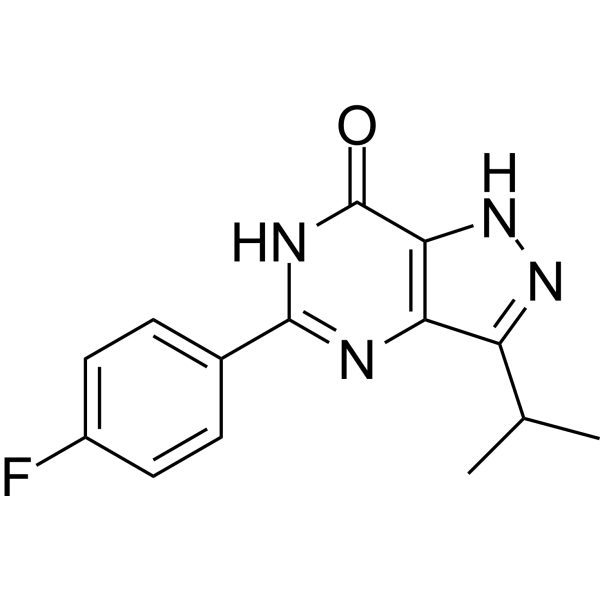
-
- HY-125102
-
|
|
IGF-1R
|
Cancer
|
|
AZ12253801 is an ATP-competitive IGF-1R tyrosine kinase inhibitor that shows ∼10-fold selectivity over the insulin receptor. AZ12253801 inhibits IGF-1R–driven proliferation in 3T3 mouse fibroblasts (transfected with human IGF-1R) with an IC50 of 17 nmol/L. The IC50 for epidermal growth factor receptor (EGFR)–driven proliferation is 440 nmol/L. Anti-tumor activity.
|
-
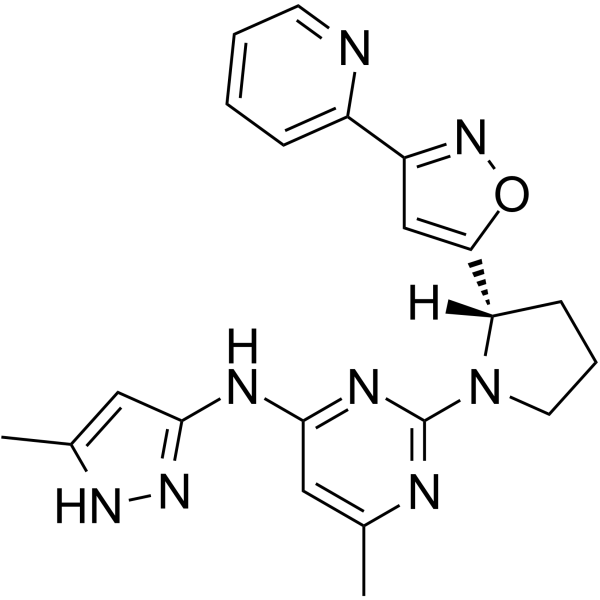
-
- HY-155328
-
|
|
HDAC
|
Inflammation/Immunology
|
|
GK444 (Compound 15a) is a HDAC1/2 inhibitor (IC50: 100 and 92 nM for HDAC1/2 respectively). GK444 inhibits Caco-2 cells with IC50 of 4.1 μM. GK444 also reduces TGF-β1 induced COL1A1 mRNA levels in primary normal human lung fibroblasts. GK444 inhibits Bleomycin (HY-108345)-induced lung fibrosis in mice .
|
-
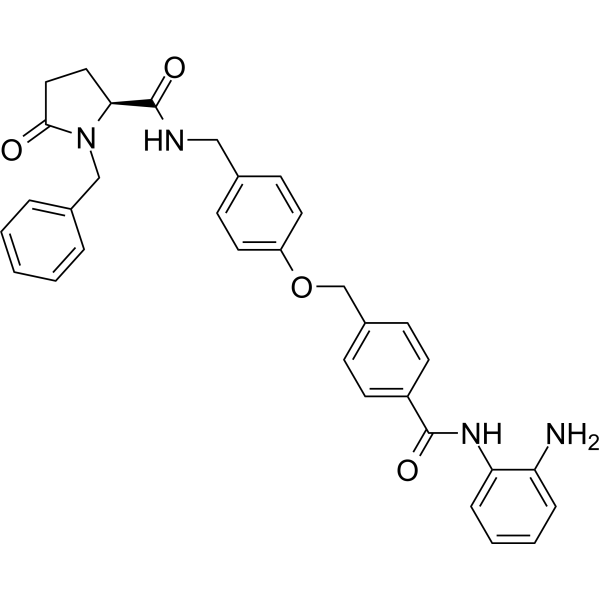
-
- HY-13948A
-
|
Angiotensin II acetate; Ang II acetate; DRVYIHPF acetate
|
Angiotensin Receptor
Apoptosis
|
Cardiovascular Disease
Endocrinology
Cancer
|
|
Angiotensin II human (Angiotensin II) acetate is a vasoconstrictor and a major bioactive peptide of the renin/angiotensin system. Angiotensin II human acetate plays a central role in regulating human blood pressure, which is mainly mediated by interactions between Angiotensin II and the G-protein-coupled receptors (GPCRs) Angiotensin II type 1 receptor (AT1R) and Angiotensin II type 2 receptor (AT2R). Angiotensin II human acetate stimulates sympathetic nervous stimulation, increases aldosterone biosynthesis and renal actions. Angiotensin II human acetate induces growth of vascular smooth muscle cells, increases collagen type I and III synthesis in fibroblasts, leading to thickening of the vascular wall and myocardium, and fibrosis. Angiotensin II human acetate also induces apoptosis. Angiotensin II human acetate induces capillary formation from endothelial cells via the LOX-1 dependent redox-sensitive pathway .
|
-

-
- HY-151872
-
|
|
HDAC
Ferroptosis
|
Cancer
|
|
HDAC-IN-48 is a potent HDAC inhibitor. HDAC-IN-48 is a hybrid molecule with great cytotoxic profile (GI50~20 nM). HDAC-IN-48 consists of harmacophores of SAHA and CETZOLE molecules. HDAC-IN-48 induces ferroptosis and inhibits HDAC proteins . HDAC-IN-48 is a click chemistry reagent, it contains an Alkyne group and can undergo copper-catalyzed azide-alkyne cycloaddition (CuAAc) with molecules containing Azide groups.
|
-
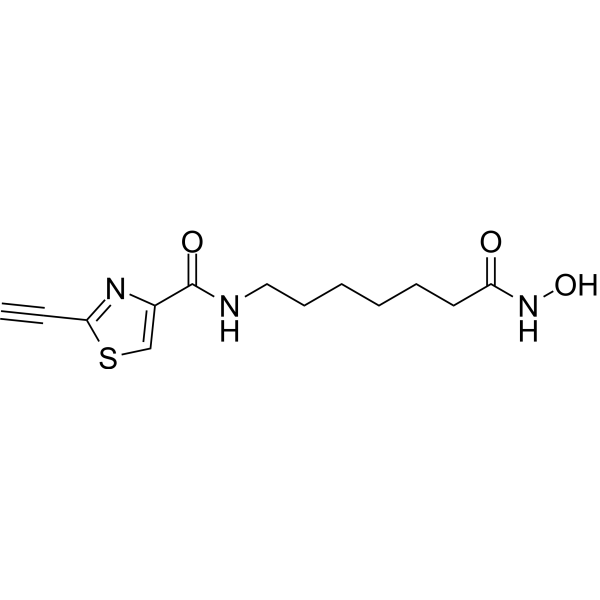
- HY-13948B
-
|
Angiotensin II TFA; Ang II TFA; DRVYIHPF TFA
|
Angiotensin Receptor
Apoptosis
|
Cardiovascular Disease
Endocrinology
Cancer
|
|
Angiotensin II human (Angiotensin II) TFA is a vasoconstrictor and a major bioactive peptide of the renin/angiotensin system. Angiotensin II human TFA plays a central role in regulating human blood pressure, which is mainly mediated by interactions between Angiotensin II and the G-protein-coupled receptors (GPCRs) Angiotensin II type 1 receptor (AT1R) and Angiotensin II type 2 receptor (AT2R). Angiotensin II human TFA stimulates sympathetic nervous stimulation, increases aldosterone biosynthesis and renal actions. Angiotensin II human TFA induces growth of vascular smooth muscle cells, increases collagen type I and III synthesis in fibroblasts, leading to thickening of the vascular wall and myocardium, and fibrosis. Angiotensin II human TFA also induces apoptosis. Angiotensin II human TFA induces capillary formation from endothelial cells via the LOX-1 dependent redox-sensitive pathway .
|
-

- HY-13948
-
|
Angiotensin II; Ang II; DRVYIHPF
|
Angiotensin Receptor
Apoptosis
|
Cardiovascular Disease
Endocrinology
Cancer
|
|
Angiotensin II (Angiotensin II) is a vasoconstrictor and a major bioactive peptide of the renin/angiotensin system. Angiotensin II human plays a central role in regulating human blood pressure, which is mainly mediated by interactions between Angiotensin II and the G-protein-coupled receptors (GPCRs) Angiotensin II type 1 receptor (AT1R) and Angiotensin II type 2 receptor (AT2R). Angiotensin II human stimulates sympathetic nervous stimulation, increases aldosterone biosynthesis and renal actions. Angiotensin II human induces growth of vascular smooth muscle cells, increases collagen type I and III synthesis in fibroblasts, leading to thickening of the vascular wall and myocardium, and fibrosis. Angiotensin II human also induces apoptosis. Angiotensin II induces capillary formation from endothelial cells via the LOX-1 dependent redox-sensitive pathway .
|
-

- HY-N2038
-
|
|
Phosphodiesterase (PDE)
|
Neurological Disease
Cancer
|
|
3,5,6,7,8,3',4'-Heptemthoxyflavone, a flavonoid from satsuma peel, is an orally available CREB activator with anti-tumor and anti-neuroinflammatory activity. 3,5,6,7,8,3',4'-Heptemthoxyflavone inhibits collagenase activity and increases the content of type I procollagen in human dermal fibroblast neoblast (HDFn) cells. 3,5,6,7,8,3',4'-Heptemthoxyflavone induces brain-derived neurotrophic factor (BDNF) expression through the cAMP/ERK/CREB signaling pathway and reduces phosphodiesterase activity in C6 glioma .
|
-

- HY-157404
-
|
|
Pim
|
Cancer
|
|
Pim-1/2 kinase inhibitor 2 (compound 5b) is a competitive PIM-1 and PIM-2 kinase inhibitor with IC50s of 1.31 μM and 0.67 μM, respectively. Pim-1/2 kinase inhibitor 2 shows in-vitro low cytotoxicity against normal human lung fibroblast Wi-38 cell line and potent in-vitro anticancer activity against myeloid leukaemia (NFS-60), liver (HepG-2), prostate (PC-3), and colon (Caco-2) cancer cell lines .
|
-

- HY-147946
-
|
|
Phosphodiesterase (PDE)
Calcium Channel
|
Inflammation/Immunology
|
|
PDE1-IN-4 (compound 2g) is a potent and selective PDE1 (phosphodiesterase-1) inhibitor, with IC50 values of 10, 145, and 354 nM for PDE1C, PDE1A, and PDE1B, respectively. PDE1-IN-4 inhibits myofibroblast differentiation of human lung fibroblasts induced by TGF-β1. PDE1-IN-4 shows anti-fibrosis effects through the regulation of cAMP (3′,5′-cyclic adenosine monophosphate) and cGMP (3′,5′-cyclic guanosine monophosphate). PDE1-IN-4 can be used for idiopathic pulmonary fibrosis (IPF) research .
|
-
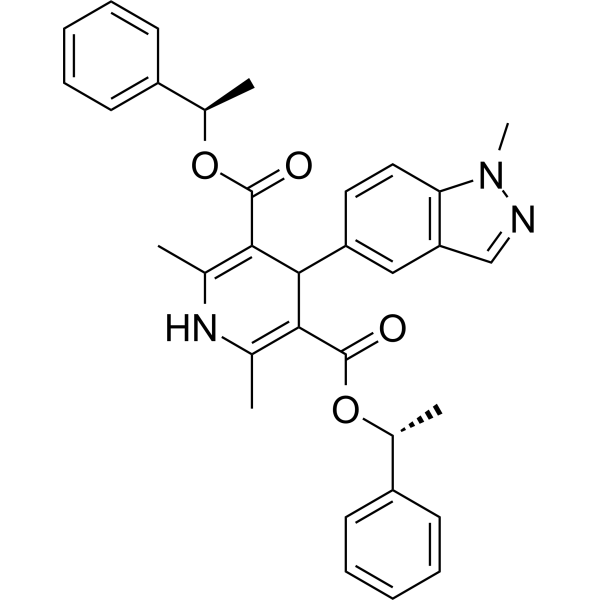
- HY-A0020
-
|
ED-71; 2-(3-hydroxypropoxy)-1,25-dihydroxyvitamin D3
|
VD/VDR
Apoptosis
|
Metabolic Disease
Inflammation/Immunology
Cancer
|
|
Eldecalcitol (ED-71) is an orally active vitamin D3 analogue, inhibits bone resorption and increases bone mineral density. Eldecalcitol (ED-71) displays anti-tumor effect and inhibits cell proliferation, migration and induces apoptosis by suppressing GPx-1 .
|
-
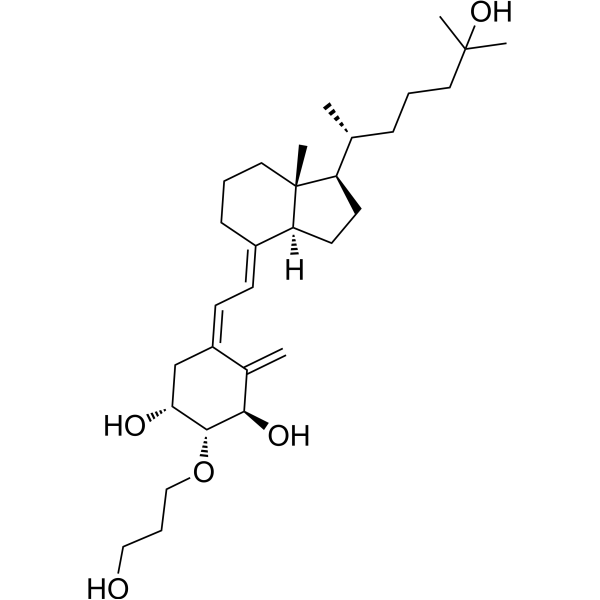
| Cat. No. |
Product Name |
Type |
-
- HY-10432G
-
|
|
Fluorescent Dye
|
|
A 83-01 (GMP) is A 83-01 (HY-10432) produced by using GMP guidelines. GMP small molecules works appropriately as an auxiliary reagent for cell therapy manufacture. A 83-01 is a potent ALK4/5/7 inhibitor .
|
| Cat. No. |
Product Name |
Type |
-
- HY-10432G
-
|
|
Biochemical Assay Reagents
|
|
A 83-01 (GMP) is A 83-01 (HY-10432) produced by using GMP guidelines. GMP small molecules works appropriately as an auxiliary reagent for cell therapy manufacture. A 83-01 is a potent ALK4/5/7 inhibitor .
|
| Cat. No. |
Product Name |
Target |
Research Area |
-
- HY-P3524
-
|
|
Peptides
|
Others
|
|
GRGESP is a collagen gel contraction inhibitor. GRGESP inhibits the spreading of human fibroblasts inside collagen gels and markedly decreased gel contraction. GRGDSP can be used for the research of connective tissue morphogenesis .
|
-
- HY-P3061
-
|
|
Bradykinin Receptor
|
Cardiovascular Disease
Endocrinology
|
|
[Hyp3]-Bradykinin, naturally occurring peptide hormone, is a bradykinin receptor agonist. [Hyp3]-Bradykinin interacts with B2-bradykinin receptors and stimulates inositol phosphate production in cultured human fibroblasts .
|
-
- HY-P5083
-
|
|
Peptides
|
Others
|
|
Lys-Phe-Glu-Arg-Gln can enhance the degradation of cytosolic proteins in human diploid fibroblasts deprived of serum .
|
-
- HY-P3544
-
-
- HY-P5261
-
|
KP1
|
Peptides
|
Metabolic Disease
|
|
SA1-III(KP1) is a bioactive peptide withanti-agingeffect and has been reported used as a cosmetic ingredient .
|
-
- HY-P0308
-
|
|
Peptides
|
Cardiovascular Disease
|
|
[Glu1]-Fibrinopeptide B is derived from fibrinopeptide B amino acid residues 1-14. Human fibrinopeptide B (hFpB), a thrombin-derived proteolytic cleavage product of the fibrinogen B beta-chain, to stimulate neutrophils (PMN), monocytes, and fibroblasts.
|
-
- HY-103289
-
|
|
Bradykinin Receptor
|
Metabolic Disease
Inflammation/Immunology
|
|
MEN 11270, a cyclic decapeptide, is a B2 kinin receptor antagonist. MEN 11270 bound with high-affinity to the B2 kinin receptor constitutively expressed by WI38 human fibroblasts, inhibiting 3H-bradykinin (BK) with a pKi value of 10.3 .
|
-
- HY-P3513
-
|
|
ERK
MMP
|
Neurological Disease
|
|
β-Neo-Endorphin is an endogenous opioid peptide. β-Neo-Endorphin is a hypothalamic “big” Leu-enkephalin of porcine origin. β-Neo-Endorphin shows activation of the Erk1/2, MMP-2 and MMP-9 .
|
-
- HY-13948A
-
|
Angiotensin II acetate; Ang II acetate; DRVYIHPF acetate
|
Angiotensin Receptor
Apoptosis
|
Cardiovascular Disease
Endocrinology
Cancer
|
|
Angiotensin II human (Angiotensin II) acetate is a vasoconstrictor and a major bioactive peptide of the renin/angiotensin system. Angiotensin II human acetate plays a central role in regulating human blood pressure, which is mainly mediated by interactions between Angiotensin II and the G-protein-coupled receptors (GPCRs) Angiotensin II type 1 receptor (AT1R) and Angiotensin II type 2 receptor (AT2R). Angiotensin II human acetate stimulates sympathetic nervous stimulation, increases aldosterone biosynthesis and renal actions. Angiotensin II human acetate induces growth of vascular smooth muscle cells, increases collagen type I and III synthesis in fibroblasts, leading to thickening of the vascular wall and myocardium, and fibrosis. Angiotensin II human acetate also induces apoptosis. Angiotensin II human acetate induces capillary formation from endothelial cells via the LOX-1 dependent redox-sensitive pathway .
|
-
- HY-13948B
-
|
Angiotensin II TFA; Ang II TFA; DRVYIHPF TFA
|
Angiotensin Receptor
Apoptosis
|
Cardiovascular Disease
Endocrinology
Cancer
|
|
Angiotensin II human (Angiotensin II) TFA is a vasoconstrictor and a major bioactive peptide of the renin/angiotensin system. Angiotensin II human TFA plays a central role in regulating human blood pressure, which is mainly mediated by interactions between Angiotensin II and the G-protein-coupled receptors (GPCRs) Angiotensin II type 1 receptor (AT1R) and Angiotensin II type 2 receptor (AT2R). Angiotensin II human TFA stimulates sympathetic nervous stimulation, increases aldosterone biosynthesis and renal actions. Angiotensin II human TFA induces growth of vascular smooth muscle cells, increases collagen type I and III synthesis in fibroblasts, leading to thickening of the vascular wall and myocardium, and fibrosis. Angiotensin II human TFA also induces apoptosis. Angiotensin II human TFA induces capillary formation from endothelial cells via the LOX-1 dependent redox-sensitive pathway .
|
-
- HY-13948
-
|
Angiotensin II; Ang II; DRVYIHPF
|
Angiotensin Receptor
Apoptosis
|
Cardiovascular Disease
Endocrinology
Cancer
|
|
Angiotensin II (Angiotensin II) is a vasoconstrictor and a major bioactive peptide of the renin/angiotensin system. Angiotensin II human plays a central role in regulating human blood pressure, which is mainly mediated by interactions between Angiotensin II and the G-protein-coupled receptors (GPCRs) Angiotensin II type 1 receptor (AT1R) and Angiotensin II type 2 receptor (AT2R). Angiotensin II human stimulates sympathetic nervous stimulation, increases aldosterone biosynthesis and renal actions. Angiotensin II human induces growth of vascular smooth muscle cells, increases collagen type I and III synthesis in fibroblasts, leading to thickening of the vascular wall and myocardium, and fibrosis. Angiotensin II human also induces apoptosis. Angiotensin II induces capillary formation from endothelial cells via the LOX-1 dependent redox-sensitive pathway .
|
-
- HY-K3002
-
2 Publications Verification
|
|
DMEM/F-12 (Dulbecco's Modified Eagle Medium/Nutrient Mixture F-12) is a widely used basal medium for supporting the growth of many different mammalian cells. Cell successfully cultured in DMEM/F-12 include MDCK, glial cells, fibroblasts, human endothelial cells, etc.
|
| Cat. No. |
Product Name |
Target |
Research Area |
-
- HY-P9939
-
|
KRN23
|
Inhibitory Antibodies
|
Others
|
|
Burosumab is a human fibroblast growth factor 23 (FGF23) neutralizing antibody that can be used for the research of X-linked hypophosphatemia (XLH) and tumor-induced osteomalacia .
|
-
- HY-P99902
-
|
FAP-IL2v
|
Interleukin Related
|
Cancer
|
|
Simlukafusp alfa (FAP-IL2v) is an immunocytokine comprising an antibody against fibroblast activation protein α (FAPα) and an IL-2 variant that only binds IL-2Rβγ. Isotype: human IgG1 .
|
| Cat. No. |
Product Name |
Category |
Target |
Chemical Structure |
-
- HY-W020044
-
-

-
- HY-114297
-
-

-
- HY-N1326
-
-

-
- HY-N12653
-
-

-
- HY-W745164
-
-

-
- HY-N5123
-
-

-
- HY-W020044R
-
-

-
- HY-B1192
-
-

-
- HY-N4298
-
-

-
- HY-119358
-
-

-
- HY-12688
-
-

-
- HY-12688A
-
-

-
- HY-13948
-
|
Angiotensin II; Ang II; DRVYIHPF
|
Structural Classification
Natural Products
Classification of Application Fields
Source classification
Endogenous metabolite
Disease Research Fields
Endocrinology
Cancer
|
Angiotensin Receptor
Apoptosis
|
|
Angiotensin II (Angiotensin II) is a vasoconstrictor and a major bioactive peptide of the renin/angiotensin system. Angiotensin II human plays a central role in regulating human blood pressure, which is mainly mediated by interactions between Angiotensin II and the G-protein-coupled receptors (GPCRs) Angiotensin II type 1 receptor (AT1R) and Angiotensin II type 2 receptor (AT2R). Angiotensin II human stimulates sympathetic nervous stimulation, increases aldosterone biosynthesis and renal actions. Angiotensin II human induces growth of vascular smooth muscle cells, increases collagen type I and III synthesis in fibroblasts, leading to thickening of the vascular wall and myocardium, and fibrosis. Angiotensin II human also induces apoptosis. Angiotensin II induces capillary formation from endothelial cells via the LOX-1 dependent redox-sensitive pathway .
|
-

-
- HY-N2038
-
|
|
Structural Classification
Flavonols
Flavonoids
Rutaceae
Plants
Citrus reticulata Blanco
|
Phosphodiesterase (PDE)
|
|
3,5,6,7,8,3',4'-Heptemthoxyflavone, a flavonoid from satsuma peel, is an orally available CREB activator with anti-tumor and anti-neuroinflammatory activity. 3,5,6,7,8,3',4'-Heptemthoxyflavone inhibits collagenase activity and increases the content of type I procollagen in human dermal fibroblast neoblast (HDFn) cells. 3,5,6,7,8,3',4'-Heptemthoxyflavone induces brain-derived neurotrophic factor (BDNF) expression through the cAMP/ERK/CREB signaling pathway and reduces phosphodiesterase activity in C6 glioma .
|
-

| Cat. No. |
Product Name |
Chemical Structure |
-
- HY-W020044S
-
|
|
|
DL-alpha-Tocopherol- 13C3 is the 13C-labeled DL-alpha-Tocopherol. DL-alpha-Tocopherol is a synthetic vitamin E, with antioxidation effect. DL-alpha-Tocopherol protects human skin fibroblasts against the cytotoxic effect of UVB[1].
|
-

-
- HY-W020044S1
-
|
|
|
DL-alpha-Tocopherol-d9 is the deuterium labeled DL-alpha-Tocopherol[1]. DL-alpha-Tocopherol is a synthetic vitamin E, with antioxidation effect. DL-alpha-Tocopherol protects human skin fibroblasts against the cytotoxic effect of UVB[2].
|
-

| Cat. No. |
Product Name |
|
Classification |
-
- HY-151872
-
|
|
|
Alkynes
|
|
HDAC-IN-48 is a potent HDAC inhibitor. HDAC-IN-48 is a hybrid molecule with great cytotoxic profile (GI50~20 nM). HDAC-IN-48 consists of harmacophores of SAHA and CETZOLE molecules. HDAC-IN-48 induces ferroptosis and inhibits HDAC proteins . HDAC-IN-48 is a click chemistry reagent, it contains an Alkyne group and can undergo copper-catalyzed azide-alkyne cycloaddition (CuAAc) with molecules containing Azide groups.
|
Your information is safe with us. * Required Fields.
Inquiry Information
- Product Name:
- Cat. No.:
- Quantity:
- MCE Japan Authorized Agent:










![Lys-[Hyp3]-Bradykinin](http://file.medchemexpress.com/product_pic/hy-p3544.gif)








![[Hyp3]-Bradykinin](http://file.medchemexpress.com/product_pic/hy-p3061.gif)












































